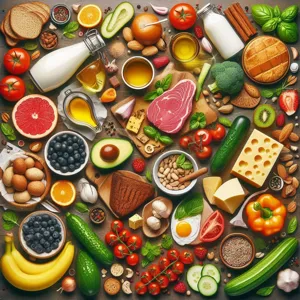In our fast-paced world, the importance of a well-balanced diet often gets overshadowed by convenience and quick fixes.
Yet, one of the most crucial components of a healthy lifestyle is fiber—a powerhouse nutrient that plays a vital role in digestion, weight management, and overall wellness. Despite its importance, many people fall short of meeting their daily fiber requirements, leading to a host of health issues. In this blog post, we’ll explore top strategies to seamlessly boost your fiber intake, transforming your meals from mundane to nutrient-dense. From delicious high-fiber foods to inventive cooking techniques and simple dietary swaps, we’ll uncover practical tips that make it easy to incorporate more fiber into your daily routine. Say goodbye to bland diets and hello to a vibrant, fiber-fueled lifestyle that not only supports your health but also tantalizes your taste buds!
1. Understanding the Importance of Fiber in Your Diet

Fiber often takes a backseat in conversations about nutrition, yet it plays a crucial role in maintaining overall health and well-being. Understanding the importance of fiber in your diet is the first step toward reaping its numerous benefits.
Fiber is a type of carbohydrate found in plant-based foods that your body cannot digest. Unlike other carbohydrates, which are broken down into sugar molecules, fiber passes through your digestive system largely intact. This unique property is what makes fiber essential for promoting digestive health. It adds bulk to your stool, helping to prevent constipation and promoting regular bowel movements.
But the benefits of fiber extend far beyond just digestive health. A high-fiber diet can help regulate blood sugar levels, making it particularly beneficial for individuals with diabetes. By slowing the absorption of sugar, fiber can help prevent blood sugar spikes, leading to more stable energy levels throughout the day.
Moreover, fiber-rich foods are often lower in calories, which can aid in weight management. They tend to be more filling, helping you feel satisfied for longer and reducing the likelihood of overeating. Additionally, studies have shown that a diet high in fiber can lower the risk of heart disease by improving cholesterol levels and reducing blood pressure.
There are two types of dietary fiber: soluble and insoluble. Soluble fiber, found in oats, beans, and fruits, dissolves in water and forms a gel-like substance, which can help lower cholesterol and stabilize blood sugar. Insoluble fiber, found in whole grains, nuts, and vegetables, adds bulk to your stool and aids in digestion.
Incorporating sufficient fiber into your daily meals is vital for optimal health. As you embark on your journey to boost your fiber intake, remember that understanding its importance is the foundation for making informed dietary choices that can enhance your overall health and vitality.
2. Types of Fiber: Soluble vs. Insoluble
Understanding the two primary types of fiber—soluble and insoluble—is crucial in your journey to boost your daily intake and enhance your overall health. Each type plays a unique role in your digestive system and offers distinct benefits, making it essential to incorporate a variety of both into your diet.
### Soluble Fiber
Soluble fiber dissolves in water to form a gel-like substance. This type of fiber is known for its ability to help regulate blood sugar levels and lower cholesterol. Sources of soluble fiber include oats, beans, lentils, chia seeds, flaxseeds, apples, citrus fruits, and carrots. When consumed, soluble fiber slows down digestion, creating a feeling of fullness that can aid in weight management. Additionally, it acts as a prebiotic, feeding the healthy bacteria in your gut and promoting a balanced microbiome.
### Insoluble Fiber
On the other hand, insoluble fiber does not dissolve in water. This type of fiber adds bulk to your stool and helps food pass more quickly through the digestive tract, preventing constipation and promoting regularity. You can find insoluble fiber in whole grains, nuts, seeds, and the skins of fruits and vegetables like potatoes, broccoli, and green beans. By including ample amounts of insoluble fiber in your diet, you support a healthy digestive system and reduce the risk of digestive disorders.
### The Perfect Balance
For optimal health, aim to include both soluble and insoluble fibers in your meals. A varied diet rich in fruits, vegetables, whole grains, and legumes not only enhances your fiber intake but also ensures you receive a plethora of vitamins and minerals. By understanding the differences and benefits of soluble and insoluble fiber, you can make informed choices that lead to improved digestion, better heart health, and sustained energy levels throughout the day. So, embrace the fiber-fueled lifestyle and get creative with your meals to reap all the rewards!
3. Recommended Daily Fiber Intake: What You Need to Know

When it comes to fiber, understanding your recommended daily intake is crucial for reaping its myriad health benefits. The general guideline suggests that adults should aim for at least 25 grams of fiber per day for women and 38 grams for men. However, as with many dietary recommendations, individual needs can vary based on factors such as age, sex, and level of physical activity.
Fiber can be broadly categorized into two types: soluble and insoluble. Soluble fiber, found in foods like oats, beans, and fruits, dissolves in water and can help lower cholesterol levels and regulate blood sugar. Insoluble fiber, on the other hand, is found in whole grains, nuts, and vegetables, and is essential for promoting healthy digestion and preventing constipation. To truly benefit from fiber, it’s important to incorporate a balanced mix of both types into your diet.
For those transitioning to a higher fiber intake, it’s essential to increase your consumption gradually. This allows your digestive system to adjust without causing discomfort. Also, don’t forget to drink plenty of water—hydration plays a vital role in helping fiber work its magic in your body.
Monitoring your fiber intake can be as simple as keeping a food journal or using nutrition tracking apps. These tools can help you gauge how much fiber you’re consuming daily and identify areas for improvement. Remember, a colorful plate filled with whole, unprocessed foods is often your best bet for hitting those fiber goals while also enjoying a rich array of vitamins and minerals.
So, whether you’re aiming to enhance gut health, manage your weight, or simply feel more energized, being aware of your fiber requirements is the first step towards a healthier lifestyle. Start incorporating fiber-rich foods into your meals today and watch your body thank you!
4. Top Fiber-Rich Foods to Include in Your Diet
When it comes to boosting your daily fiber intake, the first step is knowing which foods to incorporate into your meals. Fiber-rich foods not only promote digestive health but also offer a range of additional benefits, including improved satiety and better blood sugar control. Here are some top fiber-rich foods that can easily fit into your diet:
**1. Legumes:** Beans, lentils, and peas are among the most fiber-dense foods available. A simple cup of cooked lentils can pack a whopping 15.6 grams of fiber. Incorporating legumes into salads, soups, or stews can transform a meal into a fiber powerhouse.
**2. Whole Grains:** Swap out refined grains for whole grains like quinoa, brown rice, and whole wheat pasta. Not only do these grains provide essential nutrients, but they also deliver significant fiber content. For instance, a cup of cooked quinoa contains about 5 grams of fiber, making it an excellent base for a hearty salad or a side dish.
**3. Fruits:** Many fruits are naturally high in fiber, especially when consumed with their skin. Apples, pears, and berries are great choices. A medium-sized apple provides approximately 4 grams of fiber, while a cup of raspberries packs an impressive 8 grams. Add these to your breakfast cereals, yogurt, or enjoy them as a fresh snack.
**4. Vegetables:** Leafy greens, broccoli, carrots, and sweet potatoes are not only packed with vitamins but also fiber. For example, a cup of cooked broccoli offers about 5 grams of fiber. Experiment with different cooking methods—steaming, roasting, or incorporating them into stir-fries—to keep your meals exciting and nutritious.
**5. Nuts and Seeds:** Almonds, chia seeds, and flaxseeds are excellent sources of fiber and healthy fats. Just a handful of almonds contains about 3.5 grams of fiber, while two tablespoons of chia seeds offer a staggering 10 grams. Toss them into smoothies, oatmeal, or yogurt for an easy fiber boost.
By thoughtfully incorporating these fiber-rich foods into your meals, you can gradually increase your daily intake and enjoy the myriad health benefits that come along with it. Remember, a diverse and colorful plate is not only visually appealing but also a key to meeting your fiber goals!
5. Creative Ways to Add Fiber to Breakfast

Starting your day with a fiber-rich breakfast is one of the simplest yet most effective strategies to boost your daily intake. Not only does fiber help you feel fuller for longer, but it also supports digestive health and can stabilize blood sugar levels, setting a positive tone for your entire day. Here are some creative ways to sneak more fiber into your morning routine:
**1. Overnight Oats with a Twist:** Elevate the classic overnight oats by adding a variety of toppings that pack a fiber punch. Consider mixing in chia seeds and flaxseeds for added texture and nutrients. Incorporate diced apples or pears and a sprinkle of cinnamon for a deliciously filling breakfast that you can prepare in minutes the night before.
**2. Smoothie Boosts:** Smoothies are a fantastic way to pack in a plethora of ingredients. Add a handful of spinach or kale for greens, but don’t stop there—throw in some psyllium husk or a scoop of oat bran for an extra fiber boost. Top it off with nut butter or seeds, like hemp or pumpkin seeds, for a creamy texture and added nutrients.
**3. High-Fiber Pancakes:** Swap out regular flour for whole wheat or almond flour when making pancakes. To go a step further, mix in mashed bananas or shredded zucchini, both of which add moisture and an extra serving of fiber. Serve with a generous handful of berries, which offer antioxidants and even more fiber.
**4. Yogurt Parfaits:** Layer your favorite yogurt with high-fiber granola and fresh fruits such as berries, kiwi, or sliced bananas. For an extra crunch, sprinkle in some nuts or seeds. This not only creates a visually appealing breakfast but also provides a delicious mix of flavors and textures.
**5. Toast with a Fiber-Filled Topping:** Try whole-grain or seed-based bread as your base and top it with smashed avocado mixed with lime and a sprinkle of hemp seeds. Alternatively, spread nut butter on your toast and layer it with sliced fruits like figs or apples, which are both delicious and fiber-rich.
Incorporating these creative ideas into your breakfast routine can make it easy and enjoyable to increase your fiber intake. Start your day off right by getting inventive in the kitchen—your body will thank you for the nutritious fuel!
6. Snack Smart: High-Fiber Snacks for On-the-Go
In today’s fast-paced world, maintaining a high-fiber diet can often fall by the wayside, especially when snacking on the go. However, with a little planning, you can keep your fiber intake up while satisfying those mid-day hunger pangs. Snacking smart means choosing options that are not only convenient but also nutrient-dense, helping you stay energized and satiated between meals.
Start by stocking your pantry and bag with high-fiber snacks that are easy to grab on the run. Think of items like roasted chickpeas or edamame—both are packed with fiber and protein and can be seasoned to your taste. Alternatively, consider whole-grain crackers paired with hummus or guacamole for a satisfying crunch that delivers both fiber and healthy fats.
Another excellent option is to reach for fruits like apples, pears, or berries. These fruits are not only delicious but also rich in fiber, making them perfect for a quick snack. To make them even more filling, try pairing them with a small handful of nuts or a dollop of nut butter. The combination of fiber and healthy fats will help keep you full longer and curb those cravings.
For those who enjoy a bit of indulgence, consider high-fiber granola bars. Just be sure to check the label for added sugars and choose bars with whole grains and seeds, such as chia or flaxseeds, which can provide an extra fiber boost.
Lastly, don’t overlook the convenience of popcorn! Air-popped popcorn is a whole grain, and a perfect high-fiber snack, making it a great alternative to chips. Sprinkle it with nutritional yeast or your favorite spices for flavor without the extra calories.
By incorporating these high-fiber snacks into your routine, not only will you be fueling your body with essential nutrients, but you’ll also be setting yourself up for success in achieving your daily fiber goals. Whether you’re commuting, at work, or running errands, these smart snacks will help you stay on track without sacrificing convenience or taste!
7. Incorporating Fiber into Lunch and Dinner

Incorporating fiber into your lunch and dinner is not just a healthy choice; it can also elevate the flavors and textures of your meals. The key is to think creatively about how to enrich your dishes with fiber-rich ingredients that are both satisfying and delicious.
Start with whole grains as the foundation for your meals. Swap out white rice or pasta for quinoa, farro, or brown rice. These options are not only heartier but also pack a fiber punch that will keep you feeling fuller for longer. For a flavorful twist, consider mixing grains with herbs, spices, and citrus; a lemon-herb quinoa salad, for instance, can be a refreshing side that complements any protein.
Next, embrace the power of vegetables. Aim to fill half your plate with a colorful array of veggies. Roasting vegetables like Brussels sprouts, carrots, and sweet potatoes enhances their natural sweetness and makes for a comforting side dish. Leafy greens, such as spinach or kale, can easily be tossed into stir-fries, soups, or pasta dishes, adding both fiber and essential nutrients. Don’t forget about legumes—beans, lentils, and chickpeas can be great additions to salads, stews, or even as a filling for tacos or wraps, transforming any meal into a fiber-rich powerhouse.
Lastly, consider the impact of portion sizes and composition. Incorporating a variety of fiber sources in your meals not only diversifies your nutrition but also enhances the satisfaction factor. Enjoy your meals mindfully, savoring each bite, and you’ll find that a fiber-rich diet can be both enjoyable and nourishing. By being intentional about fiber intake during lunch and dinner, you’ll be well on your way to reaching your daily goals while delighting your taste buds along the way!
8. The Role of Whole Grains in Boosting Fiber Intake
Whole grains play a pivotal role in boosting your daily fiber intake, and understanding their benefits can help you make informed dietary choices. Unlike refined grains, which have been stripped of their bran and germ during processing, whole grains retain all parts of the grain, ensuring that you get the maximum nutritional value. This means that not only do whole grains provide a hefty dose of fiber, but they also pack essential vitamins, minerals, and antioxidants that contribute to overall health.
Incorporating whole grains into your diet is as easy as swapping out white bread for whole grain varieties, or choosing brown rice instead of its white counterpart. Foods like quinoa, barley, oats, and whole grain pasta are excellent sources of fiber, each offering unique flavors and textures that can elevate your meals. A simple breakfast of oatmeal topped with fresh fruits and nuts can provide a hearty start to your day, while a quinoa salad for lunch can keep you feeling full and satisfied.
The benefits of whole grains extend beyond just fiber content. Studies have shown that diets rich in whole grains can help reduce the risk of heart disease, improve digestive health, and even aid in weight management. The soluble fiber found in whole grains, like beta-glucan in oats, can help lower cholesterol levels and stabilize blood sugar, making it a fantastic addition for those looking to maintain a healthy lifestyle.
To maximize the advantages of whole grains, aim to make them a staple in your daily meals. Consider experimenting with different grains in your cooking—try making a hearty barley soup, a savory farro risotto, or a refreshing bulgur wheat tabbouleh. By embracing the diversity of whole grains, you not only enhance your fiber intake but also enrich your meals with flavor, texture, and nutrition. So, the next time you’re at the grocery store, reach for those whole grain options and feel the difference in your health and well-being!
9. How to Increase Fiber Intake Gradually
Increasing your fiber intake gradually is essential for both your digestive health and overall comfort. Jumping into a high-fiber diet overnight can lead to discomfort, bloating, and gas, as your body needs time to adjust to the sudden influx of fiber. Here’s how to make this transition smooth and effective.
Start by integrating fiber-rich foods into your meals one at a time. Begin with simple additions, such as swapping white bread for whole grain or incorporating a serving of legumes into your favorite dishes. For instance, consider adding black beans to your salads or chili, or mixing lentils into spaghetti sauce. These small changes can significantly boost your fiber intake without overwhelming your system.
Next, focus on portion sizes. Rather than overhauling your entire diet in one go, gradually increase your portions of high-fiber foods. If you typically eat one serving of vegetables, increase it to one and a half servings, and then to two as your body adapts. This method not only helps your digestive system adjust but also allows you to enjoy the flavors and textures of these foods without feeling rushed.
Don’t forget the importance of hydration. As you increase your fiber intake, your body will need more water to help process the added fiber effectively. Aim for at least eight glasses of water a day, and consider drinking an additional glass for every increase in fiber you incorporate into your diet. This will help minimize any discomfort and keep your digestive system functioning smoothly.
Lastly, listen to your body. If you experience any digestive discomfort, slow down your fiber increases and give yourself more time to adjust. Everyone’s fiber tolerance varies, so finding the right balance is key. By taking these gradual steps, you’ll be well on your way to enjoying the myriad health benefits of a fiber-rich diet while maintaining comfort and well-being.
10. The Benefits of Fiber for Digestive Health
Fiber is often touted as a cornerstone of digestive health, and for good reason. It plays a pivotal role in maintaining a well-functioning gastrointestinal system, ensuring that everything runs smoothly from start to finish. When you incorporate an adequate amount of fiber into your daily diet, you provide your body with the tools it needs to regulate digestion, promote regularity, and prevent a host of uncomfortable issues.
One of the most significant benefits of dietary fiber is its ability to add bulk to your stool, making it easier to pass. This helps to prevent constipation, a common ailment that can lead to discomfort, bloating, and even more severe digestive complications if left unaddressed. By keeping your digestive system on track, fiber helps you feel lighter and more energized throughout the day.
Moreover, fiber acts as a prebiotic, serving as nourishment for the beneficial bacteria in your gut. A healthy gut microbiome is essential for optimal digestion, immune function, and overall health. When you consume fiber-rich foods—such as fruits, vegetables, whole grains, and legumes—you are actively supporting the growth of these good bacteria, which can enhance nutrient absorption and promote a robust digestive system.
In addition to improving regularity and supporting gut health, fiber can also help manage weight and blood sugar levels. High-fiber foods tend to be more filling, which can curb overeating and reduce cravings. Furthermore, fiber slows the absorption of sugar, leading to more stable blood sugar levels and reducing the risk of spikes and crashes.
Incorporating fiber into your daily routine is a simple yet effective way to prioritize your digestive health. Whether it’s starting your day with a hearty bowl of oatmeal, snacking on fresh fruits and vegetables, or opting for whole grain options at mealtime, small changes can lead to significant improvements in how your digestive system functions. Embrace the power of fiber, and watch as your overall health flourishes alongside your gut!
11. Fiber Supplements: Pros and Cons
When it comes to boosting your fiber intake, fiber supplements can be a tempting option. They offer a convenient way to enhance your diet, especially for those who struggle to consume enough whole foods. However, like any dietary aid, they come with their own set of pros and cons that deserve careful consideration.
**Pros of Fiber Supplements:**
One of the most significant benefits of fiber supplements is their convenience. In our fast-paced lives, it can be challenging to maintain a balanced diet rich in fiber. Fiber supplements, available in various forms such as powders, capsules, and gummies, make it easier to increase your intake without having to meticulously plan every meal. They can be particularly helpful for individuals with specific dietary restrictions or those who are transitioning to a higher-fiber diet.
Additionally, fiber supplements can help alleviate digestive issues such as constipation and irregular bowel movements. By introducing a concentrated dose of fiber, they can promote regularity and improve overall gut health. Certain types of fiber, such as psyllium husk, are also known to support heart health by helping to lower cholesterol levels.
**Cons of Fiber Supplements:**
Despite these advantages, relying solely on fiber supplements may not be the best approach. One significant drawback is that they often lack the additional nutrients and health benefits found in whole food sources of fiber, such as fruits, vegetables, legumes, and whole grains. These foods not only provide fiber but also deliver essential vitamins, minerals, and antioxidants that are crucial for overall health.
Moreover, if not taken properly, fiber supplements can lead to digestive discomfort, including bloating, gas, or cramping. It’s essential to increase fiber intake gradually and drink plenty of water to prevent these side effects. Some people may also experience a decrease in appetite or feel overly full, which may interfere with their overall nutrition.
In summary, while fiber supplements can be a helpful tool for increasing your daily intake, it’s crucial to use them thoughtfully. Ideally, they should complement a well-rounded diet rich in whole foods. Before incorporating any supplements into your routine, it’s wise to consult with a healthcare professional to ensure they align with your individual health needs and dietary goals. Balancing convenience with nutritional quality is key to reaping the maximum benefits of fiber in your daily diet!
12. Delicious High-Fiber Recipes to Try
Incorporating more fiber into your diet doesn’t have to be a chore; in fact, it can be a delightful culinary adventure! Here are some delicious high-fiber recipes that not only tantalize your taste buds but also pack a powerful fiber punch, making it easier than ever to boost your daily intake.
### 1. Quinoa and Black Bean Salad
This vibrant salad is a perfect blend of textures and flavors. Cooked quinoa is mixed with protein-rich black beans, diced bell peppers, cherry tomatoes, and fresh cilantro, all tossed in a zesty lime dressing. With each bite, you get a satisfying crunch and a hearty dose of fiber, making it ideal as a main dish or a side.
### 2. Lentil Soup with Spinach and Carrots
Warm and comforting, this lentil soup is a fiber lover’s dream. Packed with tender lentils, vibrant spinach, and colorful carrots simmered in a savory broth, it’s not only filling but also nourishing. Serve it with a slice of whole-grain bread for a satisfying meal that will keep you full for hours.
### 3. Oatmeal Banana Bread
Who says healthy can’t be delicious? This oatmeal banana bread is a sweet treat that’s rich in fiber thanks to the oats and ripe bananas. You can easily whip it up in one bowl and customize it with nuts, seeds, or dark chocolate chips for added texture and flavor. Enjoy a slice for breakfast or as a midday snack!
### 4. Chickpea Stir-Fry
Quick and easy, this chickpea stir-fry is loaded with colorful vegetables and tossed in a savory sauce. Chickpeas are a fantastic source of fiber, and when combined with bell peppers, broccoli, and snap peas, you have a nutritious dish that’s ready in under 30 minutes. Serve it over brown rice or quinoa for a complete meal.
### 5. Baked Sweet Potato with Black Bean Salsa
This recipe combines the natural sweetness of roasted sweet potatoes with a vibrant black bean salsa. Top your baked sweet potato with a mix of black beans, corn, diced tomatoes, and avocado, seasoned with lime juice and cilantro. The result is a flavorful, fiber-rich dish that’s perfect for lunch or dinner.
### 6. Chia Seed Pudding
For a quick and satisfying breakfast or snack, try making chia seed pudding. Simply mix chia seeds with your favorite plant-based milk and let it sit overnight. In the morning, top it with fresh fruits, nuts, and a drizzle of honey or maple syrup. This creamy treat is not only high in fiber but also offers a delightful texture that will keep you coming back for more.
By experimenting with these delicious high-fiber recipes, you’ll not only enhance your meals but also effortlessly increase your fiber intake, contributing to a healthier lifestyle. So grab your apron and get cooking—your taste buds and your digestive system will thank you!
13. Common Mistakes When Increasing Fiber Intake
Increasing your fiber intake can be a game-changer for your digestive health, energy levels, and overall well-being. However, many people make common mistakes that can hinder their progress or even lead to discomfort. Understanding these pitfalls is crucial for successfully incorporating more fiber into your diet.
One of the most frequent mistakes is making drastic changes to fiber intake overnight. While it might seem beneficial to load up on high-fiber foods all at once, doing so can overwhelm your digestive system and lead to bloating, gas, and cramping. Instead, aim for a gradual increase—add fiber-rich foods slowly over a week or two to allow your body to adjust.
Another common error is neglecting hydration. Fiber works best when paired with adequate water intake. It absorbs water and expands in your digestive tract, which aids in smooth passage through your intestines. Without enough fluids, increasing fiber can lead to constipation rather than the desired digestive benefits. Be sure to drink plenty of water throughout the day, especially as you introduce more fiber into your meals.
Additionally, many individuals focus solely on soluble fiber sources, such as oats and beans, while neglecting the importance of insoluble fiber found in whole grains, nuts, and vegetables. Both types of fiber play unique roles in digestion and gut health, so it’s essential to incorporate a diverse range of fiber-rich foods into your diet.
Finally, be cautious of relying too heavily on fiber supplements. While they can be a helpful addition, whole foods provide a range of nutrients and health benefits that supplements simply can’t match. Plus, whole foods typically offer a balance of fiber types, vitamins, and minerals that contribute to a well-rounded diet.
By avoiding these common mistakes and approaching your fiber intake thoughtfully, you can enjoy the myriad benefits of a fiber-rich diet while maintaining comfort and health. Remember, it’s not just about adding more fiber; it’s about doing it the right way!
14. Staying Hydrated: Why It Matters with Fiber
When it comes to increasing your fiber intake, staying hydrated is just as crucial as the fiber itself. Imagine your digestive system as a well-oiled machine; fiber is the essential fuel that keeps it running smoothly, while water acts as the lubricant that ensures everything moves seamlessly through the gears. Without adequate hydration, fiber can actually become counterproductive, leading to discomfort, bloating, and in some cases, constipation.
Fiber works by absorbing water, expanding in your digestive tract, and helping to form stool. This process promotes regular bowel movements and supports gut health. However, when you increase your fiber intake—whether by enjoying more fruits, vegetables, whole grains, or legumes—it’s vital to also increase your water consumption. The more fiber you consume, the more fluid your body needs to help digest it properly.
Aim to drink at least 8 glasses of water a day, but adjust according to your activity level and fiber intake. Pairing your high-fiber meals with a refreshing glass of water not only aids digestion but also enhances the overall benefits of fiber. Consider infusing your water with slices of citrus, berries, or cucumber for an added nutritional boost and a refreshing twist.
Listen to your body; if you notice signs of dehydration—such as dark urine, dry skin, or fatigue—it’s time to increase your fluid intake. By prioritizing hydration alongside your fiber-rich diet, you’ll create a harmonious balance that supports your digestive health and keeps you feeling energized throughout the day. Remember, a hydrated body is a happy body, ready to reap the many benefits that fiber has to offer!
15. Tracking Your Fiber Intake: Tools and Tips for Success
Tracking your fiber intake is a crucial step toward achieving your nutritional goals and reaping the myriad benefits that fiber has to offer. Fortunately, in this digital age, several tools and tips can make this task easier and more effective.
Start by leveraging mobile apps designed for nutrition tracking. Apps like MyFitnessPal, Cronometer, and Lose It! not only allow you to log your meals but often come with pre-loaded databases rich in fiber content. Simply input your food items, and these apps will calculate not just your total caloric intake but also break down your fiber consumption. This instantaneous feedback can help you make real-time adjustments to your diet.
For those who prefer a more hands-on approach, a food diary can be an excellent tool. Dedicate a notebook to jot down your daily meals and snacks, alongside their fiber content. You can find reliable fiber data from resources such as the USDA Food Composition Database or the nutrition labels on packaging. By reviewing your entries weekly, you can identify patterns in your eating habits and make necessary changes to boost your fiber intake.
Additionally, consider setting specific fiber goals. The daily recommended intake varies by age and gender—generally around 25 grams for women and 38 grams for men—but can be tailored to your personal health objectives. By breaking down your daily goal into smaller, more manageable targets, like aiming for a certain amount at each meal, you can make your fiber journey feel less overwhelming and more achievable.
Lastly, don’t underestimate the power of community support. Engaging in online forums or social media groups dedicated to healthy eating can provide you with motivational tips, recipe ideas, and the camaraderie needed to stay committed to your fiber goals. Sharing your progress and challenges with others can greatly enhance your accountability and keep your fiber intake on track.
By employing these tools and tips, you can successfully monitor your fiber intake, ensuring it aligns with your health aspirations while enjoying the journey toward a more balanced diet!
As we wrap up our exploration of fiber-fueled strategies to boost your daily intake, we hope you feel inspired and equipped to transform your meals and snacks into nutrient-rich powerhouses. Incorporating more fiber into your diet is not just about enhancing your digestive health; it’s about embracing a lifestyle that promotes energy, satiety, and overall well-being. Whether you choose to experiment with new whole grains, add a rainbow of fruits and vegetables to your plate, or discover delicious high-fiber recipes, every small change counts toward a healthier you. Remember, the journey to better health is a marathon, not a sprint, so take your time and enjoy the process. Here’s to nourishing yourself and feeling fantastic—let’s get fiber-fueled!




































